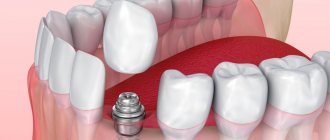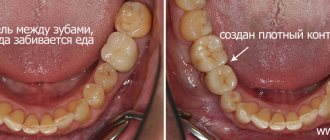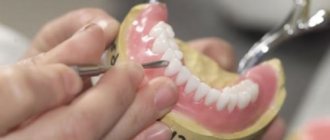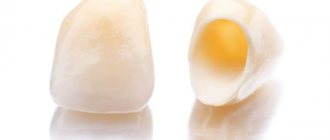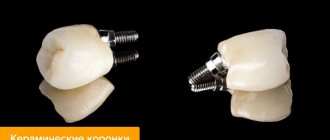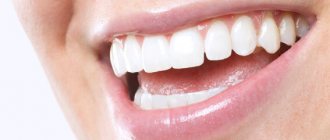- Service life of different types of crowns
- Late crown replacement
- When to change a crown
- How to change crowns
- How often are crowns replaced?
- Additional videos
Sooner or later, most people have to deal with dental prosthetics.
Perhaps the most common type of prosthetics is the so-called “dental crown” (more information about different crowns here). Many patients are their owners, but only a few patients ask questions: do dental crowns need to be replaced, how often should dental crowns be changed, etc.
Let's try to figure it out.
Dental crowns made of metal-ceramics on implants – what are they and which are better
Article navigation
- Classification
- - by type of metal alloy and method of processing it
- - by type of ceramics, method of processing and application
- - along the length of the prosthesis
- The use of metal-ceramics in prosthetics on implants
- Advantages and disadvantages
- Preparing teeth for prosthetics
- Preparing gums and implants
- Stages of making prostheses
- Methods of installing crowns on implants
- - cement fixation
- - screw fixation
- Is it possible to remove a denture?
- Service life and how to extend it
- Rules for wearing and care
- Alternatives
- How much does prosthetics cost?
Question for a specialist
Today, there are several basic materials for making a tooth crown: metal-ceramics, ceramics, metal-plastic, as well as some modern materials. Dental crowns made of metal-ceramics are the most popular in dentistry due to the excellent combination of basic characteristics - functionality, strength, low cost and aesthetics.
But despite such popularity, metal-ceramic crowns still raise some questions - for example, whether they can be placed on the front teeth and on implants, how such prostheses are manufactured, installed and removed, what their shelf life and price are. We will answer these and other questions on the topic later in the article.
What are the consequences of untimely crown replacement?
1. Destruction of the tooth under the crown with its subsequent loss.
The main function of a crown is to restore a badly damaged tooth and protect it. The first time after installation, the crown performs its function perfectly. But after a certain time, changes occur. The gingival margin rises, saliva and gingival fluid affect the cement that “secures” the crown. Over time, this cement can be partially washed out (dissolved), a microscopic gap is formed between the crown and the tooth, and the tooth begins to deteriorate under the influence of microbes and oral fluid. The most insidious thing is that these signs occur asymptomatically and unnoticed by the patient, since they are painless. Therefore, replacement of crowns often occurs untimely, when the tooth is destroyed too much and becomes simply unreliable.
Associated with this is the myth that teeth under crowns are destroyed. The truth is that crowns are simply replaced at the wrong time, but too late.
This can be prevented by timely replacement of the orthopedic structure.
2. Inflammation of the tissues around the crown . This means the gums, tooth ligament and bone tissue. A poor-quality crown can lead to the formation of a chronic inflammatory process in the gums (gingivitis, periodontitis), which is manifested by redness, bleeding when brushing teeth, aching pain in the gums and an unpleasant odor. If such a crown is not replaced for a long time, the underlying tissues become involved in the inflammatory process, which may lead to the formation of bone pockets, disruption of the ligamentous apparatus of the tooth, and local periodontitis, which in severe cases leads to tooth loss.
Photo 2.1. Inflammation of the gums near teeth under crowns, associated with inaccurate marginal fit of the crown to the tooth and with a violation of the biological parameters of tooth restoration.
Important! Make it a rule to visit the dentist for a preventive examination at least once a year, if you have any dentures, in order to notice their failure in time and prevent or correct the problem.
Classification of metal-ceramic crowns
Metal-ceramic dental crowns, as the name itself suggests, are made from two materials: their base is made of some kind of metal, which gives the product strength and durability. To improve aesthetic characteristics, the base is covered with a layer of ceramics. The classification of these orthopedic structures is presented below.
By type of metal alloy and method of processing it
It is customary to classify products according to the alloy used for the metal base:
- The basis of the prosthesis is an alloy of base metals: it can be cobalt with nickel or chromium. Chrome-nickel material is relatively inexpensive, but often causes allergies. And the alloy of chromium with cobalt is susceptible to corrosion, which leads to failure after a short time of wear. Therefore, such alloys are not recommended by professional orthopedic dentists,
- the metal “base cap” is made of an alloy of noble metals: gold, platinum or palladium (this also includes titanium of Grade 4 and ELI classes - with aluminum and vanadium). This base does not provoke allergies, has very high strength, and does not corrode. But the price of such materials is several times higher than that of “base” materials.
As for the method of processing the alloy, the metal “cap” can be made in the following ways:
- casting method: when molten metal is poured into a special mold,
- milling method: from a solid metal blank on high-precision robotic machines with program control. The latter method makes it possible to achieve the highest tight fit of the prosthesis base to the abutment installed on the implant and increase the service life of the restoration.
On a note! You can often hear a question about metal-ceramic zirconium crowns. In fact, such a concept does not exist - there are either metal-ceramic or zirconium dioxide crowns (zirconium is a soft metal, unsuitable for prosthetics, but its dioxide has the properties of ceramics - strength and white color).
By type of ceramics, method of processing and application
The ceramic component is ceramics for lining a metal base. Modern materials: porcelain, fluorapatite, leucite, lithium disilicate (for example, brands Ivoclar Vivadent, Noritake) meet any requests of dentists and patients, because You can create a metal-ceramic crown of the required color and transparency. Therefore, the restoration will be indistinguishable from neighboring teeth.
According to the method of applying ceramics to a metal workpiece, they are distinguished:
- partially veneered prosthesis: the lowest part of the metal coping remains without a layer of ceramic. And this can negatively affect aesthetics when worn for a long time, because... the edge of the gum becomes bluish due to the translucency of the metal,
- a fully lined denture with a ceramic “shoulder”: in this case, the gum does not come into contact with the metal at all, but only with the ceramic. And if the dental technician partially veneers the abutment with ceramics, then even if the gums have receded after long-term use of the prosthesis, it will not turn blue. True, this option is more often used when making prosthetics on living teeth - in the presence of implants, it is better to leave “metal + metal” contact.
Ceramics, after being applied to a metal base, can be subjected to low- and high-temperature firing. Moreover, the first option allows you to achieve higher aesthetics and translucency.
According to the length of the prosthesis
This can be a single crown, a bridge of 2-5 connected “caps” and a complete denture for the entire jaw (however, in the latter case, the prosthesis can be very heavy and will not suit some patients).
Dental implantation using the Osstem system = 70,000 rubles.
All inclusive, treatment guaranteed!
Premium implants at an affordable price. Free consultation with an implantologist +7 (495) 215-52-31 or write to us
Types, materials, manufacturing methods and photos of dental crowns:
In modern dentistry, metal-ceramic crowns and crowns based on zirconium dioxide are most often used.
Crowns such as solid-cast and stamped are made extremely rarely and mainly in cases where it is impossible or impractical to manufacture metal-ceramic or zirconium crowns.
- Metal-ceramic crowns
They are a combined crown, where the frame (cap) is made of metal, which is later covered with ceramic mass. Aesthetically and functionally, it is practically no different from your own dental tissues. - Crowns based on zirconium dioxide (zirconium)
They are a combined crown, where the frame (cap) is made of zirconium (in other words, a white mineral) which is later covered with ceramic mass. Aesthetically and functionally, it is practically no different from your own dental tissues. Zirconium crowns are more aesthetic due to increased transparency. - Temporary crowns (metal-plastic crowns)
They are made of either composite or plastic. These crowns are slightly inferior in beauty and strength to the above. But they have a huge advantage - they can be made in a matter of minutes right in the dentist’s office. They are used as an intermediate (protective) structure during the production of permanent crowns.
The use of metal-ceramics in prosthetics on implants
Metal ceramics are an excellent option for use on implants. For example, it is impossible to install pure ceramics on metal roots, since they are much stronger than the material of the upper part, and under pressure the ceramics will simply fall apart. This will not happen with metal-ceramics - when fixed to implants, the internal metal base comes into contact with their top and this combination is extremely strong and durable. But external ceramics serve only to create aesthetics.
Which teeth are crowns placed on during prosthetics?
Today, the question “which teeth are crowned on” refers less to their location on the upper or lower jaw, but to the condition of the teeth themselves. If you need to remove the defect of only one tooth, on which a crown is installed for this purpose, then its condition can be initially any. But before it comes to making a crown, the tooth requires basic treatment. If a patient develops processes such as periodontitis, then first the doctor must go through all the canals and seal them using gutta-percha pins and filling material. The quality of root filling should be checked using an x-ray. If a cyst is found near the roots, then this is not always a reason to remove the tooth, but it requires longer treatment, the prescription of antibiotics and other drugs that help restore damaged soft tissue.
If the visible part of the tooth is completely destroyed, then the crown can be installed on the root using a dental inlay. If it comes down to tooth extraction, and the person agrees to implantation, then in this case, too, a crown is used, which “crowns” the implant, imitating the visible part of the tooth. But where to put the crowns, on the upper and lower teeth, it doesn’t matter. Even if it is necessary to properly heal wisdom teeth that a person chews normally, dental crowns can be installed.
Advantages and disadvantages
When considering the pros and cons of metal-ceramic dental crowns, you need to know that they have many more advantages than disadvantages. Let's look at the pros and cons in more detail.
What are the advantages of such prostheses:
- strength and durability: the service life of metal-ceramic dental crowns is more than 10-12 years, if the base is made of gold, then they will last more than 15 years, which is similar to prostheses made of zirconium dioxide,
- aesthetic appearance: ceramics are presented in a wide variety of shades; thanks to a special scale, the doctor and patient will be able to choose the color of new teeth in accordance with the shade of those remaining in the oral cavity. In addition, throughout its entire service life, high-quality ceramics do not break off from the base, are not damaged or change their original color,
- accessibility: metal-ceramic dentures can be made by a dental technician in any dental laboratory,
- hygiene: a small amount of plaque forms on the surface of the dentures, which improves the condition of the oral cavity. But this is only possible if the patient regularly undergoes professional oral hygiene, cleaning of dentures and takes full care of new teeth on implants at home,
- low cost.
What are the disadvantages:
- allergic reactions to metal are possible,
- are not recommended for the restoration of front teeth, since a thin layer of ceramic, of course, creates an ideal appearance, but when exposed to light, the gray metal base can show through. And the gums around the prosthesis acquire a bluish tint over time (except for products on the shoulder mass). The solution is a prosthesis base and abutment made of gold or zirconium dioxide,
- impact on neighboring teeth: metal is much stronger than the material of natural teeth that are preserved in the oral cavity and, in contact with them, can cause their gradual destruction and abrasion of the enamel.
Dental crowns: types, installation, care, problems, service life
Dental crown - This is a “attachment” in the shape of a tooth, which is placed on top of it in order to cover the tooth, restore its shape, size, strength, and improve its appearance.Once cemented, crowns completely enclose the entire visible portion of the tooth located at and above the gum line.
Why do you need a dental crown?
A dental crown may be needed in the following situations:
- To protect a weakened tooth (for example, by caries) from decay, or to hold together parts of a decaying tooth;
- To restore an already damaged tooth, or a tooth that has been severely worn out;
- To isolate from the external environment and strengthen a tooth with a large filling in cases where there is too little dental tissue left;
- To hold a dental bridge in place;
- To cover a tooth that has lost its natural shape or has largely lost its natural color;
- To cover a dental implant;
- To change the appearance for aesthetic purposes.
For children, crowns can be installed on their first (baby) teeth in order to:
- Save a tooth that has been so damaged by caries that it cannot support a filling;
- Protect the teeth of a child at high risk for dental caries, especially when the child has difficulty maintaining daily oral hygiene;
- Reduce the frequency of use of sedatives and general anesthesia in children who, due to age, behavioral characteristics, or medical factors preceding treatment, are unable to fully meet the requirements for the behavior of dental patients.
In such cases, your pediatric dentist will likely recommend a stainless steel crown.
What types of dental crowns are offered?
Permanent crowns are all-metal (they are made, for example, from stainless steel, gold, gold-based alloys), they are also made from porcelain fused with a metal base, solid rubber and ceramics.
- Stainless steel crowns are prefabricated and placed on permanent teeth, usually as a temporary measure. Such a crown protects the tooth or filling for the period during which a permanent crown is made from another material. For children, stainless steel crowns are usually installed on previously prepared baby teeth. The crown covers the entire tooth, protecting it from further development of caries. When a baby tooth falls out to make room for a permanent tooth, the crown naturally falls out with it. Typically, stainless steel crowns are placed on children's teeth because they do not require multiple visits to the dentist for fitting, and therefore are not as expensive as custom crowns and the preventive services needed to keep teeth healthy without a crown.
- Crowns made from other metals are made using gold alloys, as well as palladium alloys and base metal alloys (such as nickel or chromium). Compared to other types of crowns, installing metal crowns requires the removal of less tooth tissue, and wear on adjacent teeth is minimized. Metal crowns can withstand the load applied when biting and chewing well and, perhaps, are more durable than all others. In addition, metal crowns rarely chip and rarely break. The main disadvantage is their metallic color. But metal crowns are a good choice for molars because they won't be visible to other people.
- Porcelain crowns with a metal backing can be matched to the color of adjacent teeth, unlike metal crowns. However, when wearing these crowns, adjacent teeth are subject to more wear and tear compared to metal or rubber crowns. The porcelain portion of the crown may also chip or fall off. Metal-porcelain crowns are very similar to natural teeth; in this regard, they are superior only to all-ceramic crowns. However, sometimes the metal underneath the porcelain can show up as a dark feature, especially near the gum line. This effect increases as the gum volume decreases. These crowns can be a good choice for both front and back teeth.
- Solid rubber crowns are cheaper than other crowns. However, over time they wear out and are more susceptible to cracks than metal-porcelain ones.
- Crowns made from solid ceramic or solid porcelain provide the most natural appearance and are best suited for people with metal allergies. However, they are not as durable as porcelain-metal ones, and they wear down adjacent teeth a little more than metal or rubber ones. All-ceramic crowns work well for front teeth.
- Temporary or permanent ? Temporary crowns can be made in the dentist's office, while permanent crowns can only be made in a laboratory. Temporary crowns are made from acrylic or stainless steel and can be used until the permanent ones are made in the laboratory.
Preparing a tooth for a crown?
Preparing a tooth for a crown usually requires two visits to the dentist. During the first, the tooth is examined and prepared, and during the second, a permanent crown is placed.
First visit: examination and preparation of the tooth
During your first visit to prepare for a crown, your dentist will take several x-rays to examine the roots of the tooth that will receive the crown and the surrounding bone. If a tooth has significant decay, or there is a risk of infection or damage to the tooth's pulp, root canal treatment will have to be performed before a crown can be placed.
Before the crown process begins, your dentist will administer anesthesia to numb the tooth and surrounding gum tissue. Then the tooth on which it is planned to install a crown will be ground from the chewing surface and on the sides to make room for the crown. The volume of dental tissue to be removed depends on the type of crown that is planned to be used (for example, all-metal crowns are thinner and therefore require the removal of less dental tissue than all-porcelain or metal-porcelain crowns). If, on the other hand, a significant amount of tooth structure is missing (due to decay or damage), the dentist may use a filler to “fill in” the tooth, giving it the ability to support a crown.
After adjusting the shape of the tooth, the dentist will take an impression of the tooth, which is necessary to give the correct shape to the dental crown. Impressions of the teeth above or below the tooth receiving the crown will also need to be taken to ensure that the crown will not affect your bite. The impressions are sent to a laboratory where the crown will be made. It is usually sent to the dentist's office in two to three weeks. If the crown is made of porcelain, the dentist will also select a shade that most closely matches the color of the adjacent teeth. During this first visit to the dentist, he will make a temporary crown to cover and protect the prepared tooth while the permanent one is made. Temporary crowns are usually made of acrylic and held in place with a limited-lasting cement.
Second visit: obtaining a permanent dental crown
During the second visit, the dentist will remove the temporary crown and check how the permanent crown fits on the tooth and how well it matches the color of the adjacent teeth. If both of these issues are resolved positively, the dentist will apply local anesthesia to numb the tooth, and the new crown will be placed in place, secured with a permanent cement.
Caring for a temporary dental crown
Because temporary dental crowns are exactly what they say - a temporary solution that only works until the permanent crown is ready - most dentists offer few precautions when handling them. These include the following:
- Avoid sticky and chewy foods (such as hard candy) and chewing gum, as they can grab the crown and pull it off the tooth.
- Try to chew as little as possible on the side of your mouth where the temporary crown is installed. Transfer the main effort of chewing to the other side of the mouth;
- Avoid chewing hard foods (such as raw vegetables) as this may cause the crown to become dislodged or broken;
- When flossing your teeth, pulling it outward, do it not sharply, but smoothly. By sharply pulling the floss from between the teeth in a normal manner, you can rip the temporary crown off the tooth.
What problems can arise when wearing a dental crown?
- Uncomfortable sensations or sensitivity . Your tooth that has received a new crown may become more sensitive immediately after the procedure, when the anesthesia used for it begins to wear off. If the tooth that has been crowned still has nerve in it, you may experience some sensitivity to heat and cold. Your dentist may recommend that you use a special toothpaste for sensitive teeth. The pain and sensitivity experienced when biting usually means the crown is too high for the tooth. If this is the case, contact your dentist - he can correct this problem.
- Breakage of crowns . Crowns made from solid porcelain sometimes suffer mechanical damage. If the chip on the surface of the crown is small, it can be repaired with a rubber-based composite material, leaving the crown in the mouth. If the crown has suffered extensive damage, it will have to be replaced.
- Loosening of the crown . Sometimes the cementitious substance is washed out from under the crown. This not only loosens the crown, but also allows bacteria to enter, causing decay in the remaining tooth under the crown. If you feel that your crown is starting to loosen, contact your dental office.
- Crown loss . Sometimes crowns fall out. This occurs due to improper fit, insufficient cementitious substance, or too little dental tissue to support the crown. If this happens, you should first clean the crown and front side of the tooth. You can temporarily put the crown back on using dental adhesive or a limited-life cementing agent available in stores. Contact your dental clinic immediately. The dentist will give you specific instructions on how to care for the tooth and the fallen crown for the day or two before he or she examines you. The dentist may be able to reattach the crown in place; otherwise you will have to make a new one.
- Allergic reaction . Since crowns are usually made not from pure metals, but from their alloys, including porcelain, an allergic reaction to the metals or porcelain used in the production of crowns may occur. But this happens extremely rarely.
- A dark stripe that is visible in the crown and runs adjacent to the gum line. A dark line running through the crown adjacent to the gum line is normal, especially if your crown is made of porcelain with a metal backing. This dark line is simply the metal component of the crown that is visible through the porcelain.
What are three-quarter onlays and crowns?
Onlays and three-quarter crowns are types of dental crowns. The difference between these and other crowns, which we have previously discussed, is the way they cover the tooth. A “traditional” crown covers the entire tooth, while onlay and three-quarter crowns only partially cover the tooth.
How long do dental crowns last?
On average, dental crowns last from 5 to 15 years. The lifespan of a crown depends on the degree of wear, oral hygiene and the patient’s personal habits. You should get rid of habits such as teeth grinding, clenching your teeth, you should not chew ice, bite your nails, or open packages with your teeth.
Does a tooth with a crown need special care?
Although a tooth with a crown does not require special care, remember that having a crown on a tooth does not mean that it is protected from tooth decay or periodontitis. Therefore, continue to maintain good oral hygiene, including brushing your teeth at least twice a day and flossing them daily. You should pay special attention to the area surrounding the crown, where the gum meets the tooth. Rinsing the mouth with bactericidal solutions will also help.
How much do crowns cost?
The cost of crowns varies depending on what region you live in and the type of crowns. For example, porcelain crowns are typically more expensive than gold crowns, and gold crowns are typically more expensive than porcelain-metal crowns. Typically, crowns cost from 12,000 to 25,000 rubles each.
Source: dentaldaily.ru
Is it necessary to prepare remaining teeth for prosthetics?
If, with the help of implantation, it is necessary to restore single defects, and the teeth adjacent to these defects are not in very good condition - they are chipped, they were filled several times after treatment of caries or pulpitis, then they can also be covered with crowns. Here you can use both metal-ceramic teeth (similar to those that will be placed on implants), and ceramic or ceramic-composite teeth - in any case, such teeth are pre-ground.
If you need to install a bridge, then there is no need to grind down the adjacent healthy teeth - after all, it is impossible to fix the bridge to an implant and a natural tooth at the same time. This is explained by the natural micromobility of natural teeth and the lack of such mobility in implants (they are tightly fixed in the bone and do not move). If an implantologist offers such an option, then this calls into question the doctor’s qualifications, and it is not worth treating with him. Otherwise, the patient will simply waste time and money, because... The implant will eventually become mobile and fall out along with the bridge.
Indications for use
The main reasons for the absence, for the elimination of which the dentist will suggest installing a crown on the tooth, include:
- destruction by 50% (both as a consequence of advanced caries and mechanical impact);
- the aesthetic side associated with the occurrence of chips, cracks, deterioration of color compared to the rest of the “brothers” in the series;
- damage to the coronal part (in other words, destruction of the installed prosthesis);
- critical abrasion - bruxism is a pathological disorder in which intervention will serve as protection for tissues.
Important! Bruxism is an involuntary grinding of teeth that occurs in people during nighttime sleep. First, the doctor will recommend undergoing a full diagnosis and treating the cause of the deviation, taking a course using a night guard, before direct placement.
Do I need to prepare implants and gums for prosthetics?
Not everyone knows how to insert a metal-ceramic crown into an implant. In fact, these two components are not enough - first you need to screw the abutment into the implant, and then fix the metal-ceramic “cap” on it. Either the prosthesis is connected to the abutment in a dental laboratory, and then the entire structure is fixed to the implant.
Read on the topic: what is an abutment, why is it needed in implantation, and what an abutment can be.
To achieve a beautiful gingival contour around the future restoration, 1-5 months after implantation of the implant, the plug is removed from it and a gum former is installed on top. This is required for single restorations, when the prosthesis does not contain artificial gum, which would mask the uneven gingival margin. After the contour of the mucous membrane is formed, the former is removed and an abutment is placed - and a prosthesis is placed on it. If the front tooth is being restored, then the role of the former is played by the abutment, covered with a temporary placer removed from the bite.
Stages of manufacturing metal-ceramic prostheses
How are metal-ceramic crowns made, and how long does it take to make them? Let's sort it out in order. Production includes the following stages:
- taking impressions after installing abutments on the implant,
- sending casts to the laboratory and making a working model: all anatomical formations must be made on it - tubercles and fissures. If a three-dimensional scan of the oral cavity is additionally carried out, then the digitized data is sent to a machine that grinds out a metal base - “cap”,
- fitting of a workpiece made by casting or milling: if necessary, defects are eliminated,
- lining a metal workpiece with ceramics, firing, glazing and polishing,
- fixation of the finished product to the abutment or to the base of the prosthetic gum structure (if the prosthesis is extended).
How long does it take to make a metal-ceramic crown? The production time depends on the skill of the orthopedist, dental technician, equipment and workload of the dental laboratory. On average, production takes 1-2 weeks, plus or minus 5 days. If production is carried out by a third-party laboratory located far from the implantology clinic, then the production time may increase by 2 weeks.
Let's talk further about how a metal-ceramic crown is placed on an artificial tooth.
Methods of installing crowns on implants
How to install a metal-ceramic crown is of interest to many patients. Let us next consider the sequence of how metal-ceramic dentures are placed on artificial teeth (implants).
Cement fixation - features and indications
The abutment is inserted and fixed into the implant, then the metal-ceramic crown part is placed on the aba. Between the last two components there is a layer of adhesive composition (glue), which tends to slightly dampen chewing loads.
Cement fixation is very convenient to use, but has significant disadvantages. In particular, such a crown cannot be removed without cutting. In addition, the cement sags over time, that is, a gap appears between the product and the abutment. And if excess material is used, then the implant may be overloaded.
Screw fixation - features and indications
With screw fixation, the following happens - aba into the implant. At the same time, there is a hole inside it. The crown is created from an impression, placed on the abutment, after which a small screw is screwed in on top, very firmly connecting all the parts into one whole. The screw is invisible from the outside, because the hole above it is filled with a composite composition in the shade of natural enamel.
This option is more preferable because it allows the crown to be easily removed. In addition, the load on the implant is distributed more evenly.
You can see what the patient’s smile looks like before and after installing a metal-ceramic crown on an implant in the photo.
What is better to put on chewing teeth?
Since the chewing teeth bear the bulk of the load, the crowns on them must be strong. Most often, metal-ceramic crowns are placed in the lateral sections. Metal ceramics are durable and aesthetic, but require significant grinding of dental tissue.
Zirconium dioxide has proven itself to be excellent. Its strength is comparable to the strength of metal crowns; only zirconium prostheses, unlike metal ones, are very similar to natural teeth. Another advantage of this choice is the insignificant grinding of tooth enamel before prosthetics.
All-metal crowns on teeth are cheaper. They have a long service life and are resistant to corrosion. An even more significant disadvantage of such prostheses (in addition to the low level of aesthetics) is the risk of developing an allergy to the material.
Is it possible to remove a denture?
How are metal-ceramic crowns removed from teeth? It all depends on the method of fixation. If the prosthesis is “planted” on cement, then it is first sawed and removed in parts - such a product cannot be repaired (but the implant itself remains unharmed, of course). But the orthopedic construction needs to be made new.
If screw fixation is initially chosen, the dentist drills a composite filling that covers the screw. Then he unscrews the screw itself and removes the prosthesis - here the removal is done without destroying the prosthesis, and it can be fixed to the implants again, if necessary.
You cannot remove prosthetic structures on implants yourself! The only case when this can be done (but not always necessary) is if the prosthesis is conditionally removable and fixed on certain abutments - spherical or “locators”, that is, the system provides for independent removal.
Common questions from clients
why do the gums darken near the crown??
- Error when preparing a tooth for a crown.
- Error in the manufacture of the crown (non-certified metals or the frame overlaps the ceramics on the outer surface).
- Root caries (a carious process has occurred under the crown), that is, the seal of the crown is broken.
- In all cases, urgent replacement of the structure is required. Failure to follow the recommendation will result in tooth extraction.
why does the tooth under the crown turn black??
the tooth has turned black - this is a symptom of tooth tissue destruction and requires immediate treatment. The dentist will remove the crown and evaluate the condition of the tooth. If a small part of the tooth has darkened, you can fill the tooth and make a new crown.
Is it possible to redo zirconium crowns? ?
Can. For example, if the color of the crowns is radically different from their own. In this case, the crown is sawed and removed without damaging your tooth.
Most often, it is impossible to change the color of the crown without removing it. Unless we are talking about some completely insignificant defect, which can really be eliminated by slightly tinting the porcelain.
If the discrepancy is really serious and very noticeable, the crown will have to be removed and re-fired in a dental laboratory. This is undesirable as it may change the density of the porcelain. In addition, only a crown installed on temporary cement can be removed and put back - when removing a prosthesis installed on a permanent basis, it can become irreversibly deformed.
Is it possible to change the shape of a zirconium crown??
Some changes in shape can be made if the crown is installed with temporary cement.
The ceramic on the crown chipped, why?
- Bruxism (teeth grinding).
- Technical shortcomings in crown manufacturing.
- Incorrect determination of occlusion by the dentist.
- In all cases, urgent replacement of the structure is required. It is impossible to repair high-quality ceramic crowns; replacement is required.
The crown fell out, how did that happen?
- Consultation with a dentist is required.
- If the crown falls out before a year after manufacture, most likely an error was made during prosthetics (subject to fixation with permanent cement).
- If many years have passed, then there are too many options, this requires immediate intervention from a specialist.
Double crown or two separately – which is better?
It is better to make a connected common denture for two teeth.
Why does the tooth under the crown hurt?
- In almost all cases, it indicates problems in the supporting tooth. Immediate consultation with a specialist (orthopedic dentist, therapist and surgeon) is required.
Rules for wearing and care
How long it takes to get used to metal-ceramic crowns depends entirely on the skill of the implantologist, orthopedist and dental technician. An ideally made product should feel like “native” and not cause inconvenience, i.e. no need to get used to it. It’s another matter when there were no teeth for a long time, and now, after prosthetics, the tongue occupies a slightly different position. Therefore, a lot of saliva appears, and difficulty with diction arises. In this case, adaptation may take 1-4 weeks. And to speed up the process, practice more often - read books, poems, tongue twisters out loud.
How to care for metal-ceramic prosthetic structures? Caring for metal-ceramic crowns is not much different from caring for your own natural teeth. Here are some recommendations that should be followed to ensure that the restoration remains functional and aesthetic for a long time:
- Maintain oral hygiene: how to clean metal-ceramic crowns? Just like your natural teeth - twice a day with a brush and paste, using a rinse and irrigator. You can also use special dental floss “super-floss”, but it is better not to use toothpicks and chewing gum,
- exclude excessively hard and brightly colored products: in order not to break the prosthesis (and even the implant!) and prevent it from becoming irreversibly stained - after all, it is not possible to bleach the ceramics,
- Visit your dentist regularly to assess the condition of the restoration, as well as to have your new teeth cleaned and polished so they will retain their original shade longer.
If you still have to remove the crown...
Sometimes you can hear very strange complaints from patients: “The dental crown hurts.” In fact, it is the tooth under the crown that hurts, because the crown itself is not living tissue. The question also arises: why should there be pain if the tooth is devoid of a nerve? Inflammation can also occur in the gum tissue, and it can already manifest itself as pain. Sometimes it happens that you just feel an unpleasant smell from under the crown, but there is no pain. But this is also a reason to remove dental crowns.
When dismantling such structures, it is important what dental crowns are glued to. Knowing this, you can try to dissolve the material with a substance that will not damage the tissue of the teeth and gums. After this, it will be much easier to remove the crown with forceps. It is often necessary to additionally break up the cement with a drill and a special bur so that the crown can be removed easily. The removal of the crown begins with a Kopp apparatus, a device that can make pushing movements, and ends with crown removal forceps.
There are also devices that work with compressed air. This is, for example, cronaflex. The procedure is more expensive due to the high cost of the device, but the crown is not damaged and can be reused.
If you use other methods, such as sawing, you will have to remove the dental crowns and install new ones after dental treatment. This will result in greater costs for the patient and will also take more time.
Once we know how dental crowns are removed, it remains to be seen whether the patient experiences pain during the process? If the reason for coming to the dentist is only the smell from under the dental crown, then when removing it there may not be any unpleasant sensations at all. After all, the smell may be a consequence of food and saliva getting under the crown, and not the development of caries under it. When a patient is brought to the clinic by a toothache, the dentist must first administer anesthesia, and only then get to work. Pain clearly indicates inflammation.
Whether a tooth hurts under a crown or not depends not only on its quality, and not always on how well the dentist installed it. Often, even the best dental crowns can fall off or the tooth underneath them begins to ache. This happens due to the poor condition of the gums and the sluggish inflammatory processes occurring in it. As soon as chronic inflammation worsens, pain symptoms may immediately appear.
This is why many doctors advocate long-term treatment before placing a crown on a tooth.
What are the alternatives?
As already noted, cermets can be replaced with products made from zirconium dioxide. Moreover, it can be used as “pure”, i.e. without facing, or facing with ceramic mass, and then firing. This is necessary if very white zirconium dioxide with minimal transparency is used - then the zirconium cap, after applying several layers of ceramics, will be indistinguishable from natural teeth and will last more than 20 years.
If the patient needs an extended bridge, then zirconium dioxide will make the restoration very expensive. In this situation, you can pay attention to cheaper, but lightweight and high-quality materials, for example, ceramic composite.
If the crown comes off a tooth...
This also does not mean that the tooth will have to be removed. After all, even crowns with a zirconium frame, an expensive and high-quality material, can fall out. Parting with it is an unaffordable luxury if you have the opportunity to install it again. By the way, if the crown falls out on its own, this is a guarantee that it will not be sawed. Whatever materials are used to make crowns, it is almost always possible to re-attach them to the tooth, only with new cement. The main thing is not to lose the crown and bring it to the doctor.
How much does prosthetics cost?
The price of metal-ceramic dentures on implants depends on the materials (their quality and quantity), manufacturing method, equipment of the dental laboratory and requirements for implantation. The most budget option for a crown starts at 7,500 rubles. If the price includes a titanium abutment, then add another 7-15 thousand. But all this is indicated without the cost of the implant (the price of which can be 15-70 thousand depending on the brand and model).
Author: Vasiliev A. A. (Thank you for your help in writing the article and the information provided)
At the dentist's appointment
- Try to listen carefully to the dentist about possible prosthetic options. Do not hesitate to ask questions (your understanding of the treatment process is very important).
- Make a decision on one or another prosthetic option. Ask about the timing and total cost of treatment. Ask for a detailed treatment plan indicating the full cost, payment schedules and treatment time frames.
- Check the warranty period. Read the contracts carefully. If something worries you or you have doubts, do not hesitate to take a time out.
Remember! It is better to consult several doctors before starting anything.
Avoid! Promises and bravado, if you have previously consulted with several doctors and only one promised you what others refused, then we advise you to contact those who refused.
Carefully! If the clinic lures you into paying the full amount of treatment immediately REMEMBER that you will not get it back. Try to avoid clinics with this approach to taking money despite the discounts offered.
